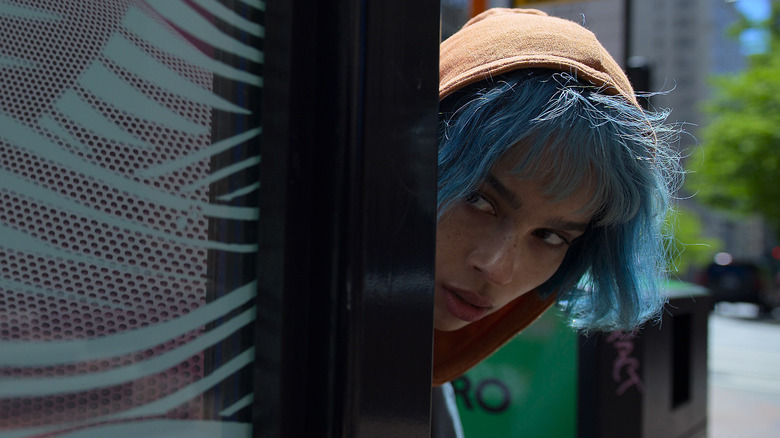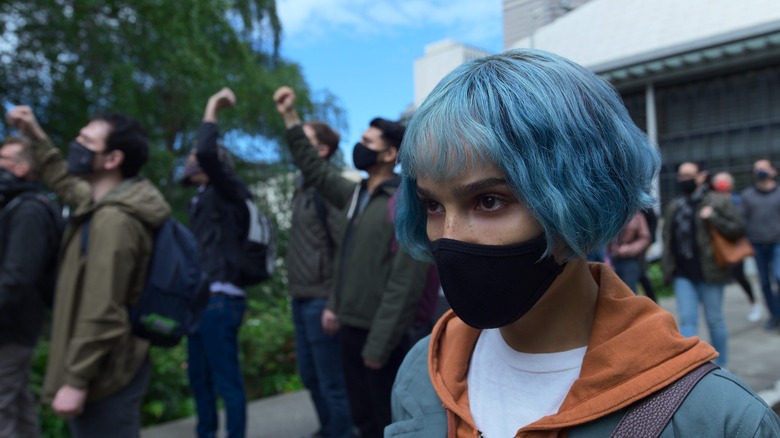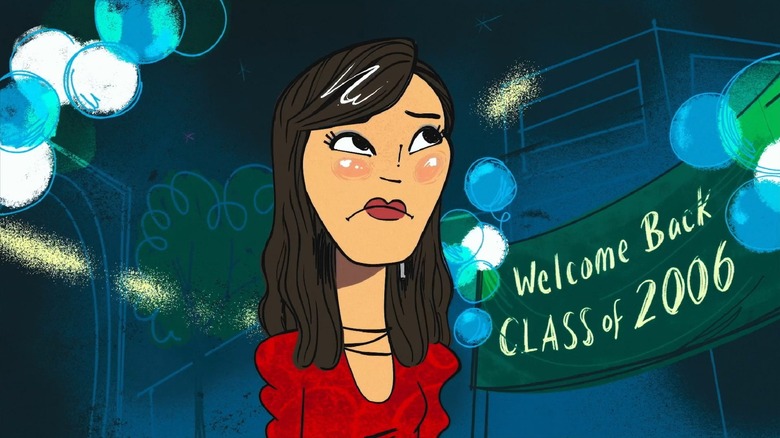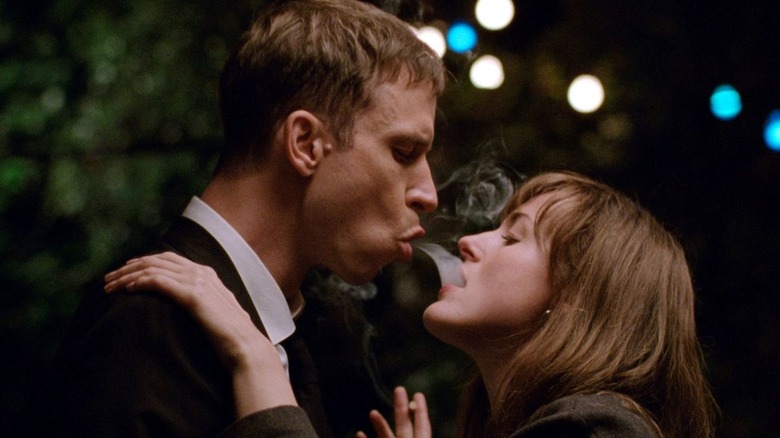Under The Radar: Kimi Is Our First Great Pandemic Movie & More February Highlights
(Welcome to Under the Radar, a new column where we spotlight specific movies, shows, trends, performances, or scenes that caught our eye and deserved more attention ... but otherwise flew under the radar. In this edition: Steven Soderbergh captures our new normal in "Kimi," "The Afterparty" continues to embrace its medium, the triumphs of Joachim Trier's "The Worst Person in the World," and "The Sky Is Everywhere" isn't afraid to get a little flashy.)
Back so soon, you ask? Well, February is the shortest month of the year and March is already shaping up to be absolutely stacked, led by the highly-anticipated "The Batman" and capped off by the encroaching arrival (or threat?) of the Academy Awards ceremony. It's in this hectic period of time that our latest installment of "Under the Radar" debuts. Caught in a much larger tide of pop culture forces, I'll once again attempt to shine a light on some of the more underseen and underappreciated options that viewers had at their fingertips in the past month of February ... or will I?
Alright, you caught me. This is where I confess that I've had a slightly more duplicitous motivation behind this column, too. To be clear, the primary reasoning behind each and every movie or show I include will always be based on the kinds of media and artists that don't enjoy the same level of popular recognition as others do. At the same time, however, sometimes a given story — regardless of its marketing muscle or viewership numbers or awards recognition — provides the perfect opportunity to single out certain narratives and overarching talking points that are worth further discussion. That's exactly why you'll soon read about Steven Soderbergh or Christopher Miller projects below, neither of whom are unknown names or undiscovered talent. In their cases, I couldn't resist the chance to sound off about very niche, specific, and some might even say under the radar aspects of their respective work that allowed me to make even broader points. So, yeah, consider me guilty ... of shamelessly using my platform to signal-boost the stuff I enjoyed watching, at least! (Insert "Dun dun DUN" sound effect here.)
But for those clamoring for true underdog representation, fear not. Joachim Trier's "The Worst Person in the World" and Josephine Decker's "The Sky Is Everywhere" also round out my picks for February, so let's get right to it!
Kimi is our first (only?) great pandemic movie
Between this and the January 2022 debut of "Under the Radar," director Steven Soderbergh has now forced my hand and compelled me to include two of his own movies on two separate editions of this newly-born column. How's that for consistency? After directing at the furious pace of seven total movies in the last five years (with really only one considered a disappointment) and especially after delivering arguably the most prescient pandemic-themed movie back in 2011, Soderbergh stands tall as one of the few filmmakers I'd ever trust — by far — to directly integrate the ongoing Covid crisis into his art. In all honesty, I'm not sure the HBO Max film "Kimi" is anything like what I would've envisioned to take the crown for Best Movie That Acknowledges The Pandemic™ (competition that includes lowlights such as Doug Liman's "Locked Down" or the Michael Bay-produced "Songbird" and highlights like Ben Wheatley's "In the Earth" or Rob Savage's "Host"), but that's exactly what makes it so great.
"Kimi" stars Zoë Kravitz as a techie shut-in named Angela, whose distrust and paranoia of the outside world has only become exacerbated by lockdown protocols. Unable to bring herself to leave her apartment without succumbing to intense and debilitating panic attacks, even after loosened restrictions (though not outright stated in the text, her character idiosyncrasies have led to many insightful takes suggesting a nuanced portrayal of someone coded to be on the autism spectrum), Angela instead watches the world go by from her window ... until forced to enter it again.
Part of the joy of "Kimi" relies on how writer David Koepp's script weaves in topics like technological paranoia and surveillance, agoraphobia and the pandemic, sexual assault and HR complicity in the workplace, and even mass protest and social unrest as matter-of-factly as possible. This extends to the actual nuts and bolts of the plot: Angela uncovers a possible murder while fine-tuning the Alexa-esque Kimi devices, which in turn leads to a corporate conspiracy, and all the while we see on a micro level how this affects Angela on a personal level.
I'll cop to my stance as "that guy" who never wanted to see the pandemic depicted in our entertainment. Thanks to Koepp's inspired script and Soderbergh's remarkably assured direction, "Kimi" proved me emphatically wrong. Reflecting our reality can actually, somehow, feel strangely hopeful.
The Afterparty: When the message fits the medium
Warning: I'm about to jump onto a soapbox once again. Chances are you've experienced the cliché of binge-worthy television shows marketed as, essentially, expanded movies. Television's inferiority complex compared to (supposedly) far more prestigious and serious-minded movies stretches back decades before "Prestige TV" was ever a thing, instilling generations of storytellers with the idea that their shows had to be something more than "just" shows. Though those sorts of eye-rolling statements have thankfully faded over the last few years, television viewers may notice that the majority of ongoing series still lean towards serialized storytelling over episodic — almost as if shows remain vaguely embarrassed of being, well, shows.
And then there's Christopher Miller's murder mystery "The Afterparty," a breath of fresh air that feels even more impressive, considering the project's origins as a movie before shifting to Apple TV+ streaming. The fun storytelling quirk of focusing on a new suspect and a different point-of-view with every episode, reinventing every hour to fit the personality and narrative demands of the main character of the week, would probably be worth a column all to itself. Specifically, though, I want to hone in on the sixth episode, titled "Zoë." After several episodes revolving around the same basic plot — successful and famous pop singer Xavier (a wonderfully pathetic Dave Franco) is killed during an afterparty following a tense high school reunion, leading to Detective Danner (Tiffany Haddish) grilling each suspect in turn — the episode told through the eyes of Zoë (Zoë Chao) not only shifts genre and tone, but an entire medium, as well.
To this point, Zoë had been pigeonholed as the flawless girl next door by Aniq (Sam Richardson) and the prize to be won back by ex-husband Brett (Ike Barinholtz). In that light, it's incredibly fitting that her coming out party takes the form of unabashed animation, finally taking control of herself in the most expressive style possible. Described by Christopher Miller himself as "the most ambitious episode to produce," "Zoë" gave the creative team carte blanche to step even further outside the box and tailor the narrative goals of the series to the strengths and advantages of animation. Zoë embodies multiple "personalities" in zany (and occasionally touching) ways and the episode forces viewers to leave our preconceptions at the door — all through the magic of animation.
Form follows function in The Worst Person in the World
Whenever an artist shows a true understanding of how to use the various storytelling tools at their disposal, we owe it to them as informed viewers to sit up and take notice. For instance, we're all likely familiar with the in media res approach of beginning a movie at its most "exciting" point, before flashing back to a comparatively more subdued moment that wouldn't have grabbed our attention otherwise. Or structuring a movie with quirky chapter titles, as has cropped up recently between "The French Dispatch," "The Last Duel," "The Power of the Dog," and more. Or the use of omniscient narration, providing an extra layer of context behind character choices that may not be apparent through dialogue. None of these examples are inherently good or bad in and of themselves, to be sure, but let's just say there's a reason filmmakers tend to rely on these as crutches to make up for weaknesses in the script.
That couldn't possibly be less applicable to "The Worst Person in the World," Danish-Norwegian director Joachim Trier's trenchant take on millennial malaise and romance. The film features every one of those potential clichés mentioned above ... but none ever actually comes across as one, because they're implemented with a strong sense of purpose and intention.
We open on an alluring shot of a 20-something Julie (a simply magnificent Renate Reinsve), smoking a cigarette in a backless dress outside of a cocktail party and whose intense dissatisfaction is framed pointedly by the beautiful Oslo, Norway cityscape. Almost immediately, we get hit with the triple-whammy of establishing chapter titles (14 in all, including the prologue and epilogue), expository narration, and various flashbacks filling in the gaps of Julie's impulsive life choices to this point. In lesser hands, this would probably be reason for concern. With Trier, what could've been interpreted as a lack of confidence instead coalesces into a singular strength of purpose.
By the time we loop back around to that party, the reason for taking an indirect approach feels clear. Every seeming indulgence, from the aforementioned examples to a mushroom trip gone horribly wrong to a breathtaking sequence where time stands still, constantly adds to our understanding of Julie. Form follows function in "The Worst Person in the World," building a solid framework upon which the rest of the film could flourish.
Style is substance in Josephine Decker's expressionistic The Sky Is Everywhere
If the young adult genre has been stuck in a creative rut for a little while now, then apparently filmmaker Josephine Decker never got that memo. The director behind such individualistic efforts as "Madeline's Madeline" and the Elisabeth Moss-starring "Shirley" might not have seemed like the most conventional choice the coming-of-age story about a teenager consumed by grief in the aftermath of her sister's sudden death. One look at "The Sky Is Everywhere," however, makes it clear that the director has lost none of her impressive grasp on visual storytelling.
Adapted from the book of the same name and with a script written by original author Jandy Nelson, "The Sky Is Everywhere" dropped with absolutely no fanfare whatsoever onto Apple TV+ streaming early last month. It's a shame, too, because Decker manages to overcome the typical pitfalls of the genre through sheer force of will — primarily thanks to actor Grace Kaufman as the grieving Lennie, becoming the latest lead actress to thrive under Decker's vision — and a thrilling sense of style that practically lifts viewers right off the ground and into Lennie's turbulent, hormonal headspace.
Music plays a key role in the film just as much as standard romance tropes do, as Juilliard-bound prodigy Lennie finds herself unable to enjoy her clarinet the way she used to. When chance (fate?) brings high school heartthrob Joe Fontaine (Jacques Colimon) into her life, Lennie is caught between her sense of mutual understanding and confusing feelings for her late sister Bailey's (Havana Rose Liu) unmoored boyfriend Toby (Pico Alexander) and the excitement of someone who gets every other aspect of her, outside of her devastating loss. Movies aren't automatically improved by heightened visual storytelling or sequences defying our usual need for abject realism ... but, similar to other entries in this list, "The Sky Is Everywhere" maximizes the effectiveness of these distinct choices through an innate understanding of when and where to use them.
An intimate duet between Joe and Lennie highlights the marketing (such as there was, at least), but stirring moments of rose bushes coming to life while the lovestruck teens listen to classical music, intense emotions exaggerated through the use of storm clouds, or magically uprooted trees representing Lennie's overturned life all stick out in the best ways. Style, Josephine Decker emphatically proves, can be substance, too.




